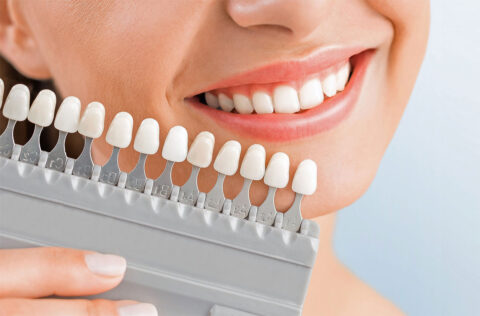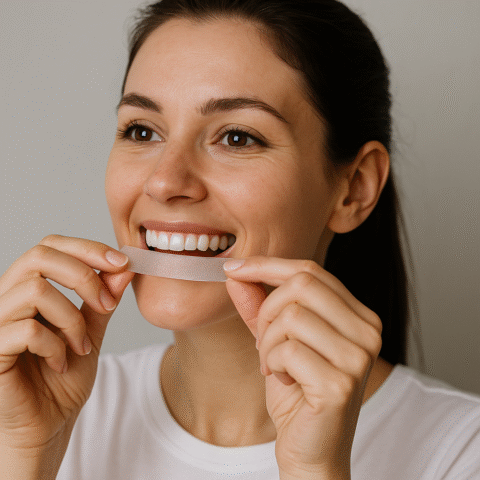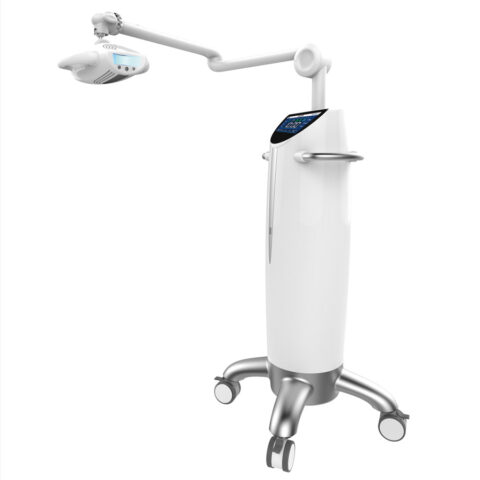
What’s the best way to whiten teeth?
What’s the Best Way to Whiten Teeth? A Comprehensive Guide
Everyone wants a whiter, brighter smile. But with numerous teeth whitening methods available, it’s essential to understand your options to choose the most effective and safe approach. Let’s look at various teeth whitening techniques, their benefits, and other considerations to help you make an informed decision when it comes to your quest for a dazzling smile!
What is teeth whitening?

Teeth whitening involves removing stains and discolouration from the teeth to enhance their appearance. Discolouration can result from various factors, including:
- Dietary habits: Consuming coffee, tea, red wine, and certain fruits can stain teeth
- Tobacco use: Smoking or chewing tobacco leads to yellowing
- Poor oral hygiene: Inadequate brushing and flossing can cause plaque buildup
- Aging: Enamel wears down over time, revealing the yellowish dentin beneath
- Medications: Certain drugs can cause tooth discoloration
The best way to professionally whiten teeth
In-chair whitening treatments
Performed by professionals, in-chair treatments use high-concentration bleaching agents such as hydrogen peroxide for immediate results.
Pros:
- Quick and noticeable results, often within one session
- Supervised by professionals, ensuring safety and effectiveness
Cons:
- Higher cost compared to at-home methods
- Potential for temporary tooth sensitivity
Beyond Ultra II or Polus Advanced – the best type of in-chair whitening system
In-chair teeth whitening remains the gold standard for achieving fast, dramatic, and long-lasting results — especially when performed using advanced technology like the Beyond Ultra II and Polus Advanced systems.
Unlike generic in-chair systems that rely solely on LED activation, the Beyond machines combine blue light with ultrasonic technology, allowing for lower-peroxide whitening gels to deliver better results with less sensitivity.
How teeth whitening works
The Beyond whitening machines use a dual-syringe hydrogen peroxide gel system:
- One syringe contains a stabilised peroxide base
- The other contains a reactive catalyst
- When mixed and applied, the combination is activated by cool LED light and ultrasonic vibrations
This vibrates the gel down into the microscopic porous of the enamel faster than any other type of whitening system, and helps it reach the stain molecules deep within the enamel, while surrounding these and ‘lifting’ the stain particles clean away.
Why is Beyond’s ultrasonic whitening system so good?
- Faster gel activation means faster whitening, even with lower hydrogen peroxide strength
- Ultrasonic technology means no reliance on heat or strong chemical concentration which makes it gentler on enamel
- Less sensitivity; in fact, clients report significantly fewer post-treatment issues compared to traditional higher-peroxide systems
- Even, consistent results as the gel is freshly mixed in a dual syringe for each session, ensuring potency and stability
- NZCTWA compliant — all TWA products and systems meet the legal safety standards for cosmetic teeth whitening in New Zealand
Why ultrasonic technology matters
The ultrasonic element in Beyond’s Polus Advanced and Ultra II is what sets this whitening system apart. Ultrasound is the very latest technology to be used in aesthetic dentistry. Traditional light-activated systems heat the tooth surface, which can lead to dehydration and sensitivity. The Beyond systems avoid this by:
- Using cool-spectrum LED light (safe for enamel and pulp)
- Adding ultrasonic energy to stimulate peroxide breakdown without heat
- Delivering a faster and deeper stain removal process
This combination allows practitioners to achieve amazing results comparable to 35% peroxide systems, as often used in a dentist clinic — without the side effects often recorded, such as tooth or gum sensitivity.
Perfect for professional practitioners
The Beyond whitening systems used by Teeth Whitening Associates’s members are trusted by hundreds of certified technicians across New Zealand. Each practitioner is trained online and certified through the New Zealand Cosmetic Teeth Whitening Association (NZCTWA), ensuring safety, consistency, and professional standards are upheld.
Whether you’re offering whitening in a beauty salon, clinic, or mobile setting, the Beyond whitening systems provide a reliable, high-end whitening service your clients will trust — and return for. And there are two whitening machines to choose from, so depending on your situation and space, there’s a machine to suit your unique business.
Other methods of teeth whitening
Custom-fitted whitening trays
When you visit your dentist, they can provide custom-made trays and professional-grade whitening gel for you to use at home. This will be using carbamide peroxide which is designed for longer periods of use, unlike hydrogen peroxide which is only effective for 20 minutes.
Pros:
- Personalized fit ensures even whitening
- Professional guidance minimises risks
Cons:
- Requires multiple applications over days or weeks
- Costlier than over-the-counter options
Whitening strips
These are thin, flexible strips coated with a peroxide-based whitening gel which are applied directly to teeth.
Pros:
- Affordable and accessible
- Easy to use at home
Cons:
- May cause uneven whitening if not applied correctly
- Potential for gum irritation

Whitening toothpastes
Dedicated whitening toothpastes normally contain mild abrasives and chemicals to remove surface stains.
Pros:
- Inexpensive and easy to incorporate into daily routine
- Helps maintain whiteness after professional treatments
Cons:
- Limited effectiveness on deeper stains
- Results take longer to appear
Baking soda and hydrogen peroxide paste
For years, people have resorted to a homemade paste combining baking soda and hydrogen peroxide to help remove surface stains.
Pros:
- Cost-effective and easy to prepare
- Mild abrasive action cleans teeth
Cons:
- Overuse can damage enamel
- Not as effective on deep stains
Oil pulling
This is the method of swishing coconut or sesame oil in the mouth to remove bacteria and promote oral health.
Pros:
- Natural method with additional oral health benefits
- Easy to incorporate into daily routine
Cons:
- Limited scientific evidence supporting whitening effects
- Time-consuming process
What are the factors to consider when choosing a whitening method?
- Tooth Sensitivity: Individuals with sensitive teeth should opt for methods with lower peroxide concentrations and consult with a dentist first to ensure their mouth health is in tip-top shape before carrying out any whitening treatment.
- Desired Results: For significant whitening, professional treatments may be more suitable. The professional can tailor the treatment to suit your level of staining/natural teeth colour and achieve the best result possible.
- Budget: Over-the-counter and natural methods are more affordable but may yield slower results. One treatment with a professional often suits a budget better than buying and trying many different types of products to see what works.
- Time Commitment: In-chair treatments offer quick results, while at-home methods require consistent application over time. One-hour appointment is all it takes to achieve your glossiest, brightest smile, and then you’re free to get on with your time!
How do you keep teeth white after a treatment?
Teeth are susceptible to staining – after all, that’s why people get them whitened in the first place! There are ways to help the effects of teeth whitening and your practitioner will discuss these with you.
Some ways to extend the effects of teeth whitening are:
- Practice good oral hygiene: brush twice daily, floss regularly, and use mouthwash
- Avoid stain-causing foods and beverages: limit intake of coffee, tea, red wine, and dark-coloured fruits
- Quit smoking: tobacco products can quickly stain teeth
- Regular dental checkups: professional cleanings help maintain oral health and whiteness

Is it safe to whiten teeth at home?
Yes, it can be safe — if you use low-concentration peroxide products and follow instructions. However, home kits are often less effective and may cause gum irritation if applied incorrectly. For best results, consult a trained whitening technician.
How long does it take to whiten teeth?
Professional treatments can whiten teeth by several shades in just one 60-minute session. At-home methods, like strips or whitening trays, typically require daily use for 1–2 weeks to see noticeable results.
What are the side effects of teeth whitening?
The most common side effect is temporary tooth sensitivity. Some users also experience gum irritation if gel contacts soft tissue. These side effects are usually mild and short-lived, especially with systems that use lower peroxide levels and cooling technology.
How long does teeth whitening last?
Results typically last 6–12 months, depending on your diet, lifestyle, and oral hygiene. Avoiding staining foods and drinks and having a touch-up treatment every few months will keep your teeth sparkly white.
Can teeth whitening damage enamel?
The question we are always asked! And the answer is No — professional teeth whitening does not damage enamel when performed correctly. A professional, trained practitioner will only use whitening gels that are pH-balanced and peroxide-controlled to avoid erosion, and systems that reduce heat exposure to keep enamel safe.
So what’s the best way to whiten teeth?
When it comes to achieving a noticeably brighter, whiter smile, in-chair teeth whitening using professional-grade systems and certified practitioners is by far the safest and best way – and for good reason.
Compared to at-home kits, whitening strips, or DIY pastes, professional systems offer superior results, greater safety, and a far lower risk of side effects. But not all in-chair systems are created equal.
That’s why at Teeth Whitening Associates, we only recommend trusted, globally recognised systems like the Beyond Ultra II and Polus Advanced whitening machines. These industry-leading devices combine cool-spectrum LED light with ultrasonic energy, allowing our dual-syringe peroxide and catalyst gel system to work faster and deeper — without requiring high peroxide concentrations that can damage enamel.

Here’s why professional whitening with Beyond whitening systems stands out:
- ✔️ Faster results — typically 5–8 shades whiter in just one session
- ✔️ Lower sensitivity — thanks to ultrasonic activation and cool light
- ✔️ Fully NZCTWA-compliant — safe for non-dental professionals
- ✔️ Tailored for individual clients — peroxide strength, treatment time, and gel application can all be adjusted
- ✔️ Enamel-safe — no acidic pH, no heat-based drying, no structural damage
Conclusion: If you want whitening that works without the risks, and you value comfort, safety, and clinical-grade results, the answer is clear:
The best way to whiten teeth is with a professional in-chair treatment using TWA’s Beyond Ultra II or Polus Advanced whitening machines and medical-grade gels.
Want to know more about how safe teeth whitening is? Check out this study on the effects of teeth whitening vs orange juice on enamel – the results may surprise you!
Want to start your own teeth whitening business, and become a trained, certified practitioner using the Beyond whitening system? Check out our business start-up packages that offer you everything you need to be successful.